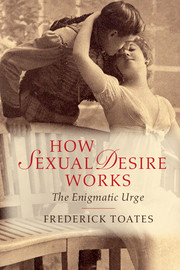Book contents
- Frontmatter
- Dedication
- Contents
- List of figures
- Preface
- One What is enigmatic about sexual desire?
- Two Explaining desire: multiple perspectives
- Three Sexual desire in a broad context
- Four An incentive-based model
- Five Sex and levels of organization
- Six Sexual attraction
- Seven Shades of desire from simple to complex
- Eight Details of the brain and desire
- Nine Arousal
- Ten The consequences of sexual behaviour and associated expectations
- Eleven Sexual familiarity and novelty
- Twelve Inhibition, conflict and temptation
- Thirteen How did sexual desire get here?
- Fourteen Setting the trajectory: link to adult sexuality
- Fifteen Sexual desire in interaction
- Sixteen Representations of sex
- Seventeen Sexual addiction
- Eighteen Variations in desire: general principles
- Nineteen Some forms of desire at the fringes
- Twenty The toxic fusion: violence and sexual desire
- Twenty one Sexually associated (serial) murder
- Twenty two Concluding remarks
- Notes
- References
- Index
Fifteen - Sexual desire in interaction
Published online by Cambridge University Press: 05 October 2014
- Frontmatter
- Dedication
- Contents
- List of figures
- Preface
- One What is enigmatic about sexual desire?
- Two Explaining desire: multiple perspectives
- Three Sexual desire in a broad context
- Four An incentive-based model
- Five Sex and levels of organization
- Six Sexual attraction
- Seven Shades of desire from simple to complex
- Eight Details of the brain and desire
- Nine Arousal
- Ten The consequences of sexual behaviour and associated expectations
- Eleven Sexual familiarity and novelty
- Twelve Inhibition, conflict and temptation
- Thirteen How did sexual desire get here?
- Fourteen Setting the trajectory: link to adult sexuality
- Fifteen Sexual desire in interaction
- Sixteen Representations of sex
- Seventeen Sexual addiction
- Eighteen Variations in desire: general principles
- Nineteen Some forms of desire at the fringes
- Twenty The toxic fusion: violence and sexual desire
- Twenty one Sexually associated (serial) murder
- Twenty two Concluding remarks
- Notes
- References
- Index
Summary
Then the lusts of the flesh, the longing for money, and the melancholy of passion all blended themselves into one suffering, and instead of turning her thoughts from it, she clave to it the more, urging herself to pain, and seeking everywhere occasion for it. She was irritated by an ill-served dish or by a half-open door.
(Gustave Flaubert, 1856/2010, p. 187)Sexual desire probably does not usually exist in isolation, though for some people it might best be understood in these simplified terms. As a more general principle, sexual desire locks into interaction with other processes and only by looking at its interactions can it be understood. This chapter describes three such interactions.
Attachment, care-giving, love and romance
Sexual desire interacts with a motivation that is variously described as seeking ‘companionship’, ‘love’, ‘attachment’ or ‘romance’. Attachment is essential for some to express sexual desire, in which case sexual desire needs to be understood in terms of its links with this primary motivation. This is illustrated by a number of personal accounts, such as the following: The pop singer Madonna wrote (Madonna, 1992, p. 3): ‘Sex is not love. Love is not sex. But the best of both worlds is created when they come together.’ Meston and Buss (2009, p. 30) give the witness of a 25-year-old woman: ‘We were both sixteen-year-old virgins and had been dating for three months. I pushed for us to have sex because I wanted to show him that I loved him. I wanted to give him something that no one else could have.…I probably lost my virginity out of a need to be loved’, and ‘Sex to express love is about being able to put feelings into actions. With different kinds of love there are different ways to express that love through action. When I physically and/or mentally desire someone I may choose to show that desire through sexual actions.’
- Type
- Chapter
- Information
- How Sexual Desire WorksThe Enigmatic Urge, pp. 269 - 293Publisher: Cambridge University PressPrint publication year: 2014



